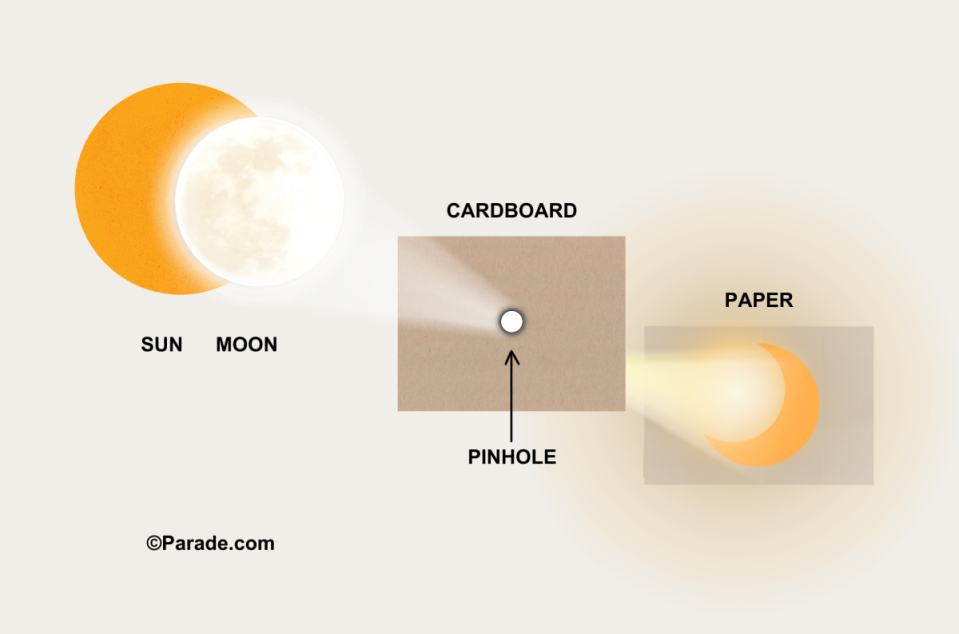How to Build a Pinhole Camera to See the Total Solar Eclipse on April 8

Eclipse Pinhole Camera DIY
On Monday, April 8, 2024, the total solar eclipse in Aries will grace the skies and close out an emotional two-week eclipse season that has turned everything on its head. This eclipse will be nearly five minutes long at peak totality, and if you don't have a pair of solar eclipse glasses on hand for safe viewing, you can create your own DIY eclipse pinhole box to see the show! Because this upcoming eclipse is a total solar eclipse, the moon completely obscures the sun from view in the sky. Although it's a beautiful sight to see, experts say you should never stare directly at the sun without using proper eye protection.
When Is the Next Eclipse? 2024 Eclipse Dates
The next eclipse takes place on Monday, April 8, 2024, with the solar eclipse in Aries, closing out the cycle that began with the lunar eclipse in Libra on March 25, 2024.
Where Is the Solar Eclipse Path of Totality?
The total solar eclipse will be visible across sixteen states: Texas, Oklahoma, Arkansas, Missouri, Kentucky, Tennessee, Illinois, Indiana, Ohio, Michigan, Pennsylvania, New York, Vermont, New Hampshire, and Maine. However, Tennessee and Michigan are not in the path of 100% totality.
How Long Will the Eclipse Last?
The duration of the eclipse on April 8, 2024, depends on where you're located. Most U.S. cities in the path of totality will experience about four to four and a half minutes of darkness. If you don't live in the direct viewing path of the total solar eclipse, the event is being livestreamed for free all across the web.
Total Solar Eclipse 2024 Time & Path:
Eagle Pass, Texas, U.S: 1:27 p.m. CDT, 4 minutes 24 seconds
Kerrville, Texas, U.S: 1:32 p.m. CDT, 4 minutes 25 seconds
Fredericksburg, Texas, U.S: 1:32 p.m CDT, 4 minutes 25 seconds
Dallas, Texas, U.S: 1:40 p.m. CDT, 3 minutes 52 seconds
Idabel, Oklahoma, U.S: 1:45 p.m. CDT, 4 minutes 19 seconds
Russellville, Arkansas, U.S: 1:49 p.m. CDT, 4 minutes 12 seconds
Cape Girardeau, Missouri, U.S: 1:58 p.m. CDT, 4 minutes 7 seconds
Carbondale, Illinois, U.S: 1:59 p.m. CDT, 4 minutes 10 seconds
Bloomington, Indiana, U.S: 3:04 p.m. EDT, 4 minutes 3 seconds
Indianapolis, Indiana, U.S: 3:06 p.m. EDT, 3 minutes 51 seconds
Cleveland, Ohio, U.S: 3:13 p.m. EDT, 3 minutes 50 seconds
Erie, Pennsylvania, U.S: 3:16 p.m. EDT, 3 minutes 43 seconds
Rochester, New York, U.S: 3:20 p.m. EDT, 3 minutes 40 seconds
Oakfield, Maine, U.S: 3:31 p.m. EDT, 3 minutes 23 seconds
Sign up for our newsletter for more astrology content delivered straight to your inbox.
What is an Eclipse Pinhole Camera?

Photo Illustration by Lauren Ash
A pinhole camera is a simple camera without a lens that projects the image of an object through a small hole or aperture. Light passes through the pinhole to cast an image of the object on the second surface, allowing you to safely observe the light of the solar eclipse.
Note: It’s unsafe to stare directly at the sun at any time. Please review the official American Astronomical Society viewing safety guidelines to prepare for the solar eclipse.
How to Make an Eclipse Pinhole Camera
Making a pinhole camera at home is easy. You'll only need a few supplies: cardboard, white paper, and a push pin.
1. Start by taking your piece of cardboard and making a tiny hole directly in the center of it using your pin. Make sure the edges of the hole are smooth, or it could obstruct your view.
2. During the eclipse, turn your back toward the sun and hold your pinhole cardboard over your shoulder, catching the light of the sun with the paper.
3. Take your sheet of white paper and hold it at a distance. Through the pinhole, you should see an inverted image of the eclipse appear on the paper.
4. As the total solar eclipse reaches 100% coverage, you'll notice the light on the paper fading away, reminiscent of the sun being engulfed.
5. You can change the size of the image projected by holding the paper at different distances from the pinhole. Holding it further away causes the image to appear larger while holding it closer makes the image smaller.
UP NEXT: Your April 2024 Horoscope Is About Embracing Uncertainty.

